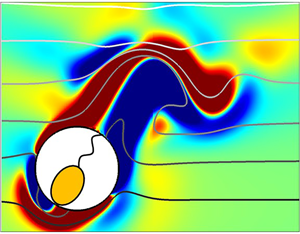Article contents
Motion of an inertial squirmer in a density stratified fluid
Published online by Cambridge University Press: 22 October 2020
Abstract

We investigate the self-propulsion of an inertial swimmer in a linearly density stratified fluid using the archetypal squirmer model which self-propels by generating tangential surface waves. We quantify swimming speeds for pushers (propelled from the rear) and pullers (propelled from the front) by direct numerical solution of the Navier–Stokes equations using the finite volume method for solving the fluid flow and the distributed Lagrange multiplier method for modelling the swimmer. The simulations are performed for Reynolds numbers ( $Re$) between 5 and 100 and Froude numbers (
$Re$) between 5 and 100 and Froude numbers ( $Fr$) between 1 and 10. We find that increasing the fluid stratification strength reduces the swimming speeds of both pushers and pullers relative to their speeds in a homogeneous fluid. The increase in the buoyancy force experienced by these squirmers due to the trapping of lighter fluid in their respective recirculatory regions as they move in the heavier fluid is one of the reasons for this reduction. With increasing the stratification, the isopycnals tend to deform less, which offers resistance to the flow generated by the squirmers around them to propel themselves. This resistance increases with stratification, thus, reducing the squirmer swimming velocity. Stratification also stabilizes the flow around a puller keeping it axisymmetric even at high
$Fr$) between 1 and 10. We find that increasing the fluid stratification strength reduces the swimming speeds of both pushers and pullers relative to their speeds in a homogeneous fluid. The increase in the buoyancy force experienced by these squirmers due to the trapping of lighter fluid in their respective recirculatory regions as they move in the heavier fluid is one of the reasons for this reduction. With increasing the stratification, the isopycnals tend to deform less, which offers resistance to the flow generated by the squirmers around them to propel themselves. This resistance increases with stratification, thus, reducing the squirmer swimming velocity. Stratification also stabilizes the flow around a puller keeping it axisymmetric even at high  $Re$, thus, leading to stability which is otherwise absent in a homogeneous fluid for
$Re$, thus, leading to stability which is otherwise absent in a homogeneous fluid for  $Re$ greater than
$Re$ greater than  $O(10)$. On the contrary, a strong stratification leads to instability in the motion of pushers by making the flow around them unsteady and three-dimensional, which is otherwise steady and axisymmetric in a homogeneous fluid. A pusher is a more efficient swimmer than a puller owing to efficient convection of vorticity along its surface and downstream. Data for the mixing efficiency generated by individual squirmers explain the trends observed in the mixing produced by a swarm of squirmers.
$O(10)$. On the contrary, a strong stratification leads to instability in the motion of pushers by making the flow around them unsteady and three-dimensional, which is otherwise steady and axisymmetric in a homogeneous fluid. A pusher is a more efficient swimmer than a puller owing to efficient convection of vorticity along its surface and downstream. Data for the mixing efficiency generated by individual squirmers explain the trends observed in the mixing produced by a swarm of squirmers.
- Type
- JFM Papers
- Information
- Copyright
- © The Author(s), 2020. Published by Cambridge University Press
References
REFERENCES
More et al. Supplementary Material
This animation depicts the effect of increasing the fluid stratification on the steady motion of a puller and a pusher with $|\beta|=3$ and $Re=50$. Increasing the stratification stabilizes a puller and destabilizes a pusher. The contours show the out of plane vorticity component. The grey lines are dimensionless isopycnal values separated by 1 unit with darker shade corresponding to a higher value
- 23
- Cited by



